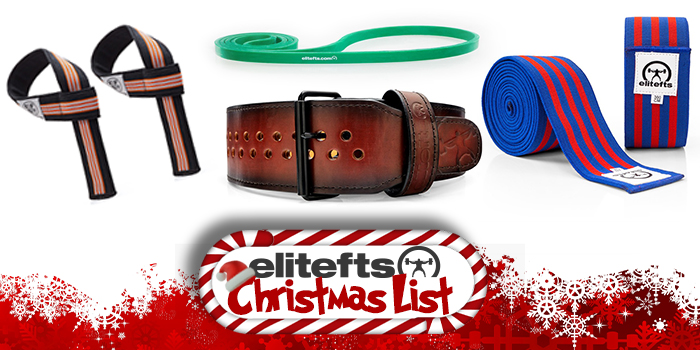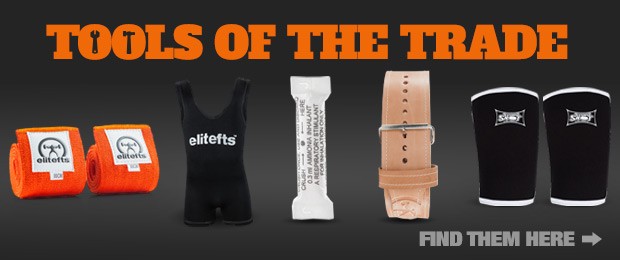
The Bodybuilding for Powerlifting series describes how you can incorporate bodybuilding methods into your powerlifting training to experience big benefits in strength and aesthetics. Lately, we’ve turned things upside down and started to look at how powerlifting can help your bodybuilding, and this special holiday edition explains how to use powerlifting equipment to take your hypertrophy to the next level.
In case you don’t know, I’m a bit of a gear whore. Yeah, I lift raw — but I love my equipment. All of it! And so I’ve tried dozens of different kinds of wraps, straps, sleeves, and belts. Shoot, I even dig the smell of a fresh pair of Kraits.
Share Your Christmas List — Win $500
So, you can probably imagine that when I’m knee-deep in offseason training, it sometimes gets a little frustrating when I know I probably shouldn’t just throw on a pair of wraps and crank out a set of squats 100 pounds heavier than I’ve scheduled! Even if you’re not quite as much of a gear whore, you’ve probably noticed that there are a lot of restrictions on different types of equipment in powerlifting, based on what division or federation you choose to compete in.
In my opinion, all that makes powerlifting equipment seem a little intimidating for lifters who aren’t well versed in competition or even just training for pure strength. And that’s too bad — because powerlifting equipment can be a huge benefit for the bodybuilder. The trick is to use the right equipment, in the right ways.
Use Your Gear as a Tool — Not a Crutch
I think the idea of gear as a crutch is the real fear of most lifters who eschew equipment. They think that if they start using straps or wraps, they’ll come to rely on them, and they won’t be able to lift without them. Of course, that’s a logical fallacy – the idea of a slippery slope – and regardless, it’s not really relevant if you’re a bodybuilder. All that matters is how you look, and if using equipment allows you to train heavier and harder, build more muscle, and ultimately look better, then you should use it!
The trick is not allowing the gear to do too much of the work for you. Knee wraps are a great example! If I throw on a jacked-up pair of three-meter Kraits, I’m getting a huge bounce off the hole on my squats. That means my quads have to do less work, and as a powerlifter, I can take better advantage of my core and posterior chain without. But if you’re a bodybuilder, you probably want your quads to do more of the work! In that case, you have to balance the tradeoff between being able to use more weight, and the fact that your body is doing a bit less of the work. In my opinion, this balance is entirely individual, but I find that it’s usually best to wear a pair of light wraps to find that balance. (More on knee wraps below.)
You also need to make sure that you don’t use your technique in unintended ways. For example, let’s say you’re doing a wide-grip partial deadlift to help to develop your upper back. If you throw on a belt and use it to get better leverage from your lumbar spine, you’re not helping yourself at all. But if you use wrist wraps to keep your wrists straight on pressing movements, you’ll find that you’re better able to activate your triceps. Be aware of the possibility of these types of unexpected consequences, and make sure that you always focus on building a strong mind-muscle connection to perform each and every rep as perfectly as possible. Equipment can never replace your knowledge of your own body!
Finally, just be aware of the learning curve associated with almost all powerlifter gear. In general, that learning curve really isn’t too steep (knee wraps are an exception). But movements performed in gear will always feel a little bit different than those performed without it, and so if you throw on straps or a belt for the first time, things will probably feel a bit…off. Don’t be intimidated by that – just give yourself a training session or two to adjust.
My Top-5 Powerlifting Gifts for Bodybuilders
1. A Good Belt
Yes, bodybuilders need to use belts! But not for the same reason as powerlifters. Many lifters think, mistakenly, that the primary purpose of a powerlifting belt is to support the lower back. It does offer some support, but really, you should be using the belt to help you to brace correctly, by breathing deeply into your diaphragm and bracing your abs. The belt helps by giving you something to push your abs against, helping you brace harder (think about an isometric lift versus just flexing) and giving you kinesthetic feedback so that you know you’re breathing correctly.
That’s not what bodybuilders want, though, because that style of breathing inflates the belly instead of helping to develop a Y- or X-frame with a tapered waist. Instead, you want to use the belt as a reminder to keep your air high in your chest and to use your abs to pull your waist in. That means wearing the belt as tight as you possibly can, and using it as often as possible. Remember: it’s not providing support for the lower back — at least, not enough to keep you safe during heavy lifts. If you’re training heavy, you need to breathe and brace just like a powerlifter does.
Now, don’t get it twisted: wearing a tight belt all the time isn’t going to magically melt fat off your waist. But it will help you to develop the muscular endurance and familiarity needed to keep your waist tight when you’re posing.
2. Wrist Straps
Wrist straps are sometimes considered to be taboo, as they’re not allowed in powerlifting competitions. But as a bodybuilder, you don’t care about lifting in meets — you care about growing as much muscle as possible, and having a strong grip really won’t help you to do that. Moving a ton of weight on upper-back exercises will! In fact, using straps will allow you to relax your hand, which can make it easier to focus on using the lats instead of the arms when performing pulling movements.
3. Knee Wraps
In the section above, I explained how I generally recommend a pretty moderate knee wrap for bodybuilders. There are several reasons for that besides the fact that you want to use more weight but don’t want to let the wraps do too much of the work for you. First, depending on which type you use, knee wraps can be really difficult to master. But if you choose a less aggressive wrap, there’s really not much to them: even putting them on loosely will provide a bit of a boost out of the hole on moderate-intensity squats. Furthermore, aggressive wraps are typically too uncomfortable to wear during the multiple-rep sets you should be using as a bodybuilder.
On the other hand, lighter wraps tend not to offer enough support, so don’t waste your time with those. They’re good for a powerlifter intentionally using them for practice in wraps without heavy loads, but because they won’t let you use additional weight, they won’t help the bodybuilder very much.
I recommend the elitefts Heavy Wraps for most lifters. You can use the heavies on more than just barbell squats, too: they’re useful for hack squats and lighter leg pressing, too.
4. Bands
While they’re traditionally used for the squat, bench, and deadlift, there’s virtually no limit to the ways you can incorporate bands into your training. In fact, they can be particularly effective when used to make assistance exercises harder and more productive. Try adding bands to your lat pulldowns and leg presses – they’ll force you to maintain tension on the muscle throughout the entire range of motion, making those exercises even more brutally effective.
5. A Little Motivation
Many bodybuilders struggle with the idea of gaining weight – after all, you don’t want to get fat! But the truth is, building an impressive physique will be a lot easier if you have the patience to put up with a little chub. It’ll allow you to add muscle faster, keep your joints feeling a little healthier, and likely make your offseason diet more tolerable. Besides, if you’re rocking the tank version, no one’s going to know that you don’t have a six pack: all they’re going to see are the massive guns!
Wrapping it Up
If you’ve followed this series for a while, you know that a big part of embracing the dark side means being openminded. In fact, I think that might be one of the single biggest predictors of success in any context, but it’s especially important in lifting. Because so much about training and diet is unique to your body and your situation, a willingness to try new things is essential for eventually finding the most productive way to train for you. And, just like any other tool, powerlifting equipment can be part of that journey – if you use it correctly.










